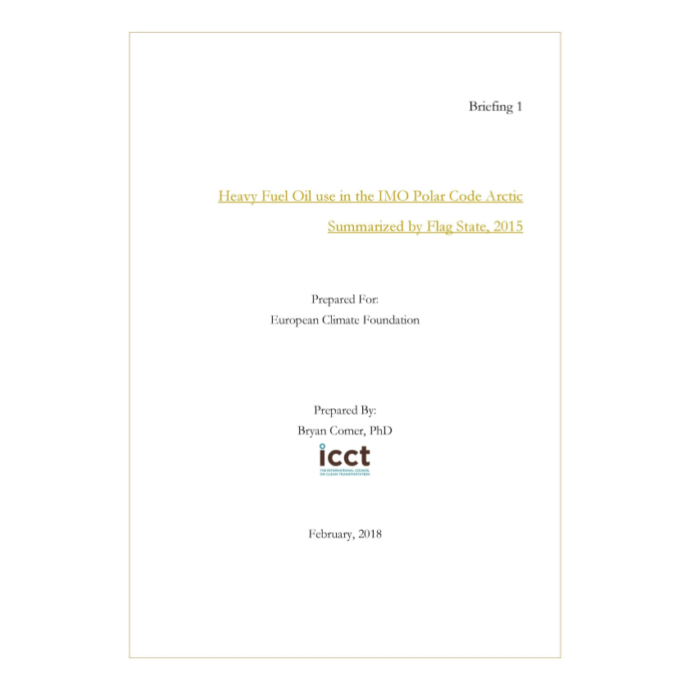Five briefing papers prepared by Bryan Comer PhD, The International Council on Clean Transportation (ICCT)
The use of heavy fuel oil (HFO) as a marine fuel poses serious environmental and economic risks, especially in ecologically sensitive areas like the Arctic. Using HFO is risky not only because of potential fuel oil spills, but also because burning it produces harmful air and climate pollutants, including black carbon (BC). As ship traffic increases in the Arctic, the risk to the Arctic environment and its peoples will also increase.
These briefings look at HFO use by flag state, ship type, ship owner, cruise ships,| fishing vessels in the IMO Polar Code Arctic, 2015.
Briefing 1 – HFO use in 2015 by flag states
There are eight Arctic states; however, ships that operate in the Arctic fly many flags. This briefing paper takes a closer look at the use and carriage (as fuel) of HFO by ships operating in the Arctic, summarized by flag state, focusing on ships operating in Arctic waters as defined in the IMO’s Polar Code, which we refer to as the “IMO Arctic”.
Briefing 2 – HFO use in 2015 by ship type
Many different types of ships operate in Arctic waters. IHS, a company that, among other things, maintains a list of commercial ships and their characteristics, categorizes ships into various categories called “ship classes” which describes, generally, the ship type (e.g. cruise, fishing vessel, general cargo, etc.). This briefing paper takes a closer look at the use and carriage (as fuel) of HFO and BC emissions by ships, summarized by ship type.
Briefing 3 – HFO use in 2015 by ship owner
This briefing paper takes a closer look at the use and carriage (as fuel) of HFO by ships operating in the Arctic, summarized by group beneficial owner (GBO). We focus on ships operating in Arctic waters as defined in the IMO’s Polar Code, which we refer to as the “IMO Arctic”.
Briefing 4 – HFO use in 2015 by cruise ship
Many types of ships use HFO, including cruise ships. While Arctic cruises offer an opportunity for people to learn about this ecosystem and the peoples who call the Arctic home, these journeys pose a threat to the Arctic environment through air and climate pollution emissions, including BC, and through the risks of HFO spills.
This paper takes a closer look at the use of HFO by cruise ships in Arctic waters as defined in the IMO’s Polar Code, which we refer to as the “IMO Arctic”.
Briefing 5 – HFO use in 2015 by fishing vessels
Many types of ships use HFO, including fishing vessels. While commercial fishing is vital to food security and economic prosperity, it also poses a threat to the Arctic environment through air and climate pollution emissions, including BC, and through the risks of HFO spills.
This paper takes a closer look at the use of HFO by fishing vessels in Arctic waters as defined in the IMO’s Polar Code, which we refer to as the “IMO Arctic”.

